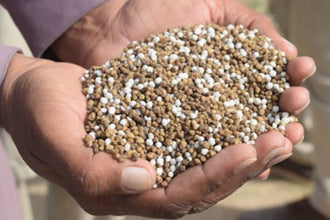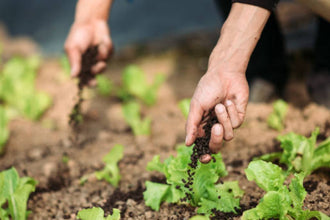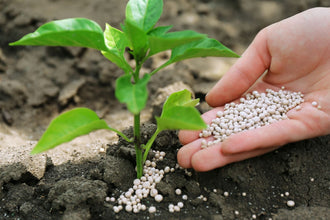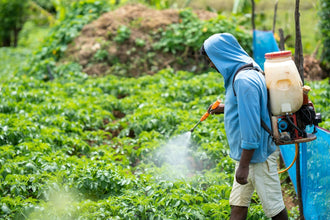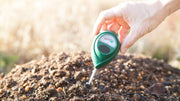
A fertilizer soil test shows you exactly what your garden needs before you start throwing money at plant food. Most people skip this step and then scratch their heads wondering why their plants look terrible even after regular feeding. Your soil has all the answers, but you need to know how to ask the right questions.
Testing your soil before adding fertilizer saves you cash and keeps your plants healthy. Lots of gardeners just dump fertilizer everywhere hoping something good will happen, but soil that already has too much nitrogen can actually hurt your plants. Too much fertilizer creates weak plants that get sick easily and bugs love to munch on them.
Why Your Garden Depends on Good Soil Testing
Your plants live in the soil, not above it. They can only grab nutrients when the soil has the right pH level. Most vegetables and flowers like soil between 6.0 and 7.0 pH, but blueberries want acidic soil around 4.5 to 5.5 pH.
A fertilizer soil test shows you these hidden things that control how well your plants grow. Soil pH matters way more than most people think. Iron gets stuck in soil that's too alkaline above 7.5 pH, so your plants get yellow leaves even when there's plenty of iron around. Phosphorus gets locked up in soil that's too acidic or too alkaline, making plants weak and stunted.
Testing also tells you what nutrients are already there. Soil naturally has different amounts of nitrogen, phosphorus, and potassium. Adding fertilizer to soil that already has lots of phosphorus wastes your money and can stop other nutrients from working right.
What Your Plants Actually Need
Different nutrients do different jobs for your plants. Nitrogen makes leaves green and helps plants grow big. Phosphorus helps roots grow strong and makes more flowers. Potassium keeps plants healthy so they can fight off diseases and handle dry spells better.
Your fertilizer soil test results show these levels in numbers that might look confusing at first. Most home soil tests tell you what to do for regular garden plants. Sandy soil usually needs more fertilizer because nutrients wash away fast when it rains. Clay soil holds onto nutrients longer but sometimes has drainage problems that mess with the roots.
Most soil test reports show how much organic stuff is in your soil. Good garden soil has about 3 to 5 percent organic matter, which feeds all the tiny bugs and worms that make soil healthy. If your soil doesn't have much organic stuff, you need to add compost before fertilizer will work well.
The Secret Life in Your Soil
Your soil has millions of tiny living things that help your plants eat. These good bacteria and fungi team up with plant roots, trading nutrients for plant sugars. Chemical fertilizers can mess up these partnerships when you use too much or use them wrong.
Some soils hold onto nutrients better than others. Clay soil is like a sponge that soaks up nutrients and keeps them around for plants to use. Sandy soil is more like a strainer where nutrients wash right through. Your fertilizer soil test tells you which type you have so you know how often to feed your plants.
Getting Your Soil Test Right
Taking good soil samples makes all the difference between helpful results and confusing numbers. Lots of people mess this up and get test results that don't really show what their soil is like.
When you test matters for getting good results. Spring works best for most gardens because you can fix problems before you start planting. Don't test right after heavy rain or during really dry weather because wet or dry soil can give you wrong numbers.
Take samples from different spots in your garden. Different areas often have different nutrient levels, especially if the people who lived there before added stuff randomly. Mix dirt from 8 to 10 different spots to get numbers that show what your whole garden is really like.
How to Take Good Soil Samples
Clean off any leaves or mulch before you dig up your sample. Dig down about 6 to 8 inches for most garden plants, or 3 to 4 inches for grass areas. Stay away from compost piles, spots where you just added fertilizer, or places where pets like to hang out because these can mess up your results.
Use clean tools so you don't contaminate your sample. A soil tool works best, but a clean small shovel works fine too. Stainless steel tools won't change your test results, but don't use galvanized tools because they can add zinc to your dirt.
Here's what you need to do:
• Collect about one cup of soil total from all your different spots • Mix it all together really well • Let muddy soil dry out naturally before you send it in • Most soil labs need about 1 to 2 cups of dried soil for a complete fertilizer soil test
Picking the Right Test
Basic soil tests check pH and the big three nutrients like nitrogen, phosphorus, and potassium. These tests cost about $15 to $30 and give you enough info for most home gardens. Fancier tests add micronutrients and organic matter analysis for $40 to $60.
Home test kits give you quick answers but they're not as accurate as lab tests. Digital pH meters work pretty well for checking how acidic your soil is, but those nutrient test strips often give you different results every time. Professional lab tests give you better information and tell you exactly what fertilizer to use.
University extension offices offer cheap soil testing in most places. These tests come with detailed explanations and fertilizer suggestions that work for your area. Private labs cost more but they're faster and might offer special tests you can't get anywhere else.
Making Sense of Your Test Results
Soil test reports have numbers that look confusing at first, but once you understand the basics, you can make smart fertilizer choices. Most reports rate nutrient levels as low, medium, or high, and tell you what to do for each one.
pH numbers under 7.0 mean your soil is acidic, while numbers over 7.0 mean it's alkaline. Most garden plants do fine with pH between 6.0 and 7.5, but some plants are picky. Blueberries, azaleas, and rhododendrons want acidic soil, while clematis and lavender like alkaline soil better.
Fertilizer recommendations usually show up as pounds per 1,000 square feet or pounds per acre. Home gardeners need to figure out what this means for their garden size. A 10 by 10 foot garden bed is 100 square feet, so you divide the recommendations by 10 to get the right amount for that space.
Understanding What the Numbers Mean
Low nutrient levels mean your soil needs fertilizer to grow healthy plants. Medium levels mean your soil has enough nutrition for most plants. High levels mean you should skip adding more of that nutrient because too much can cause problems.
Too much phosphorus causes environmental problems when it washes into streams and lakes. Many old lawns and gardens have high phosphorus levels from years of fertilizer use. Your fertilizer soil test helps you avoid adding phosphorus you don't need while focusing on nutrients your soil actually lacks.
Some soil tests show buffer pH readings that tell you how much lime or sulfur you need to change your soil pH. Soil with lots of organic matter and clay fights pH changes more than sandy soil. These buffer readings help you figure out exactly how much stuff to add.

When to Test Your Soil
Fall testing gives you time to fix soil problems before spring planting starts. Lime and sulfur work slowly to change soil pH, taking 3 to 6 months to show their full effect. Adding organic matter also needs time to break down and mix into your soil.
You should test intensive vegetable gardens and flower beds every year with a fertilizer soil test. Established flower gardens and lawns only need testing every 2 to 3 years unless you notice plant problems. Container gardens are different because potting soil changes fast with watering and feeding.
Recent fertilizer applications mess with test results, so wait at least 6 to 8 weeks after your last feeding before taking samples. Fresh compost and manure can also give you wrong readings, especially nitrogen levels that change quickly as organic stuff breaks down.
Best Times for Testing Throughout the Year
Spring samples work best in most places because soil conditions settle down after winter freezing and thawing. Summer testing can show different results because plants are actively using nutrients and you're watering regularly. Winter samples from frozen soil might not show you what conditions are really like during growing season.
New gardens should get tested before planting and again after the first growing season. Starting soil conditions often change a lot once you begin regular watering, fertilizing, and adding organic matter. That second test shows you how your gardening practices change your soil chemistry.
Planning Your Fertilizer Strategy
Your fertilizer soil test results point you toward the right products and amounts for your specific garden. Generic fertilizer advice often misses the mark because it doesn't consider what makes your soil unique.
Organic fertilizers work differently than synthetic ones and might be better choices based on your test results. Compost and aged manure give plants nutrients slowly while making soil healthier over time. Synthetic fertilizers provide quick nutrition but don't improve long-term soil health.
Balanced fertilizers have equal amounts of nitrogen, phosphorus, and potassium, like 10-10-10 blends. Special fertilizers target specific needs that your soil test reveals. High-nitrogen fertilizers boost green leafy growth, while low-nitrogen options work better for flowering plants and established grass.
Matching Fertilizer to Your Soil Type
Sandy soils work better with organic fertilizers that release nutrients slowly over time. Quick-release synthetic fertilizers can wash away before plants can use them in fast-draining sandy soil. Clay soils hold nutrients longer and can handle stronger fertilizer applications without runoff problems.
Your fertilizer soil test might show that you need specific nutrients instead of complete fertilizers. Here's what different deficiencies look like:
• Iron supplements fix yellow leaves in alkaline soil • Bone meal adds phosphorus to soil that lacks it without excess nitrogen • Kelp meal provides potassium and trace minerals naturally • Compost improves overall soil structure and feeds beneficial microorganisms
Slow-release fertilizers match how plants naturally take up nutrients better than quick-release products. Coated fertilizers release nutrients based on soil temperature and moisture levels. Organic options like fish meal and seaweed feed soil organisms that gradually give nutrients to plant roots.
Get Your Garden Off to the Right Start
Smart gardeners always test their soil before making fertilizer decisions because guessing leads to sick plants and wasted money. Your fertilizer soil test gives you the specific information you need to build healthy, productive garden soil that keeps your plants thriving year after year.
Knowing what's actually in your soil helps you pick the right organic fertilizer and schedule for long-term garden success. Stop guessing and start with a proper soil test that guides your fertilizer choices and timing for the healthiest plants you've ever grown.




